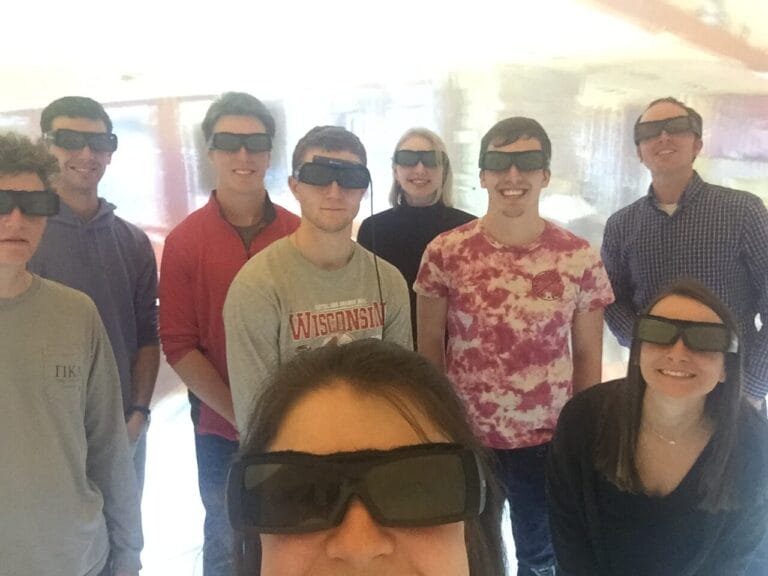

Tech courses take top spots with students
Each year we countdown the top 10 courses undergraduate students take during Summer Term. Last year’s top ten list featured two high tech courses that have students studying video games and virtual reality – and learning some surprising things along the way.


“One of the main things I want students to take from this course is how to look at the games they play with a more critical eye,” says Krista-Lee Malone, teaching faculty in the School of Education and instructor of Curriculum and Instruction 277: Videogames & Learning, which landed as a top course during Summer Term 2022.
Ross Tredinnick, research staff with the Wisconsin Institute for Discovery, teaches another 2022 top course, Design Studies 579: Virtual Reality. He says he wants students to walk away with skills to build a 3D application. But students might be surprised to learn that virtual reality has applications that could help solve a slew of practical issues.
“That’s what I get most excited about,” Tredinnick says. “How can this tech actually be used to help people and improve their lives?”
Why are these two courses still so popular in 2023? Read more about them and how these two instructors teach digital tools in an engaging way that connects classroom learning to the real world.
Casting a critical eye on gaming
“When I was a kid playing video games, I didn’t think about who was represented in them and who was not represented,” says Malone, whose love for the field started with tabletop games. “It’s great to talk about this [in class] and see a lightbulb moment for students about how race, culture and other things play out on video game screens.”
Malone takes a unique approach and helps students explore equity, diversity and inclusion issues in video games.
She gives an example from World of Warcraft, a 20-year-old game that’s still played today. She says gender standards play out even in the trolls and elves that populate the game. “We have this idea of beauty and other traditional qualities considered feminine or masculine that even carry over to creatures that don’t exist,” she adds.
With her PhD in anthropology, Malone approaches the asynchronous, 3-credit course from that angle. She says that video games are powerful learning tools, and in this course she helps students investigate the ways in which games “educate and enculturate” players and how these lessons expand beyond the game worlds. Many students who take the course come from a computer science background, but a variety of majors are represented.


In the course, students critically reflect on merits and drawbacks of gaming by exploring six video games, including We Become What We Behold and Tranxiety, a role-playing game that explores early transition anxieties, focusing on topics such as HRT, family dynamics, friendships, being publicly trans and mental illness. With each game, students learn about a specific topic, engage with the game, do readings and journal on their experience.
“I take a very anthropological approach to this course, but with all the same learning goals – what are things we learn in games and how do we learn them?” Malone says. “Most importantly, I want students to look at all the games they play more critically.”
Virtual reality helping in the real world
Tredinnick also encourages his students to critically explore tech.
Survey topics in his 3-credit, asynchronous virtual reality course include computer graphics and 3D modeling, human perception and psychology, human computer interaction and user interface design – and historical perspectives on virtual reality technology.


“One of the first things students read in this course is from the 1960s,” says Tredinnick, who has a background in both VR and video game development. “Virtual reality was of course primitive back then, a huge mechanical system that hung from the ceiling. You could put your eyes up to it and see 3D graphics.”
Students in his course learn how VR first played a role at NASA, how users were frustrated with it in the 1990s because it was too slow, and how it developed into the fully immersive Oculus VR headset then got purchased by Facebook and turned into Meta.
They also learn a bit about non-entertainment VR applications with promise in the medical and mental health fields to help medical professionals better visualize the interior of the human body, for example, and to rewire the brain and support mental health challenges.
But students definitely get hands-on experience. Assignments all use a 3D software content editing tool called Unity. They go through the entire process of building a 3D application and then deploying it.


“Students are still wowed about virtual reality,” he adds. “Not everyone has done it or used it. It’s not as ubiquitous as a cell phone. A course like this gives them a reason to learn more and think about how they can apply it in their lives.”
The video games course, which meets the Comm B requirement, will be taught next in fall 2023 and spring 2024, and the virtual reality course will be taught next in spring 2024. Both courses will be offered during Summer Term 2024. Check your course guide for more information.
Learn more about Summer Term courses and share your summer studies and more with #MyBadgerSummer.
